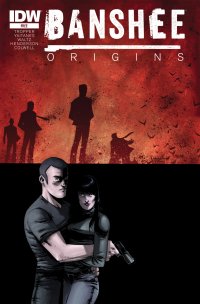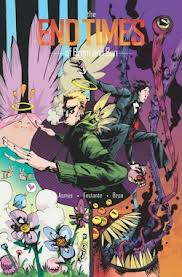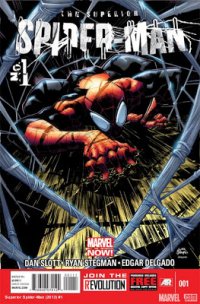Banshee Origins #1 (IDW, free download)
By Jeb D.
Anyone considering Cinemax’s new crime drama Banshee, premiering tonight (1/11/13) might want to download this free pdf of IDW’s tie-in/prequel comic, set in 1997 (I assume the TV series is set in present-day, but don’t actually know that). Writers David Schickler and Jonathan Tropper set up the premise (secret alliances / romance among the members of a Ukranian gangster’s crew) that will evidently drive the series, and artist Mike Henderson (whose Masks and Mobsters is worth checking out as well) brings noir-ish grit and some stylish excitement during the book’s heist/car chase scene. I don’t know that I’d be bowled over by this as a standalone comic (particularly if it remains stuck in a stasis period before the beginning of the TV show proper), and if the TV show’s writers are doing their job, there’s nothing here we need to know that we won’t get from the show itself at some point, but it’s more polished than some of the other media property tie-ins we see out there (Henderson’s work, in particular, has a consistency that sets it apart), and certainly worth the download.
 Star Wars #1 ($2.99, Dark Horse)
Star Wars #1 ($2.99, Dark Horse)
by D.S. Randlett (@dsrandlett)
The past couple of months have been rife with Star Wars news thanks to Disney buying Lucasfilm and speculation about an Episode VII film, and the possibility of new films that follow the EU model of showing stories in the universe that don’t revolve around folks named Skywalker. Not that the franchise hasn’t been plugging along in its very ancillary media forms like TV Shows, comic books, and T-Shirts. The Disney news brought a different spin to the franchise in its own way, or else there is something in the air that just so happens to coincide with it, but the creative folks involved with the franchise seem to be leaving the prequels behind (where they can), and getting back to the world and the vibe that made the original films so beloved. So now we have depictions of Darth Vader as a pickup truck, and it’s totally great!
Unless there’s a really fun hook (like the Bond mash up of the surprisingly solid Agent of the Empire), I don’t typically give Star Wars books much consideration. Here, the hook is Brian Wood, one of comics’ brightest talents. Creatively, he’s a had a great time lately with The Massive, commonly lauded as one of the best books on the stands. But only because it is. Wood specializes in telling stories that are smart, have a solid sense of character, and are thrilling. He’s up to his old tricks here, telling a story that at once promises big adventures and examines the psychological toll of battle.
The basic conceit of this series is that we’re seeing what happened between the films Star Wars and The Empire Strikes Back, beginning just days after the assault on the Death Star. It’s the original trilogy characters, it’s the original trilogy world. So far, it seems to work. Wood’s writing manages to strike an effective balance between the feel of the original films and his own voice. For example, we never, ever would have seen his version of Princess Leia on film, but she still feels true to the character that we all know. Leia is actually the real standout here, with Wood writing her as really strong and not simply snarky.
Carlos D’Anda’s art is pretty good, but also pretty uneven. He is great at giving the proper sense of scale and detail to the massive ships and sleek space fighters, but he seems to struggle with characters and body language. His version of C-3P0 is especially awkward, but then I haven’t seen very many comics artists really get him right. He doesn’t sink the book or anything, but his characters don’t have quite the right feel, but he might grow into them as the series progresses.
Rating: 




Out of a Possible 5 Stars
The End Times of Bram and Ben #1 (Image, $2.99) 
By Adam Prosser
In 1995, Tim LaHaye and Jerry B. Jenkins published Left Behind: A Novel of the Earth’s Last Days. An action thriller based on the premise that almost a third of the world’s population vanishes overnight, the book and its many eventual sequels became massive successes among a certain percentage of the population, despite not actually being any good. Why? Because the book is based on the philosophy of “Premillennial Dispensation”—the idea that the Bible (and particularly the Book of Revelations) provides a detailed, prophetic guide to the eventual end of the world, one that can be broken down and charted in minute detail. In this narrative, the Rapture hits one day, whisking away all the REAL Christians (that is, all the people LaHaye and Jenkins agree with, theologically) and setting the stage for seven years of increasing horror as the Earth is ruled by the Antichrist, during which time anyone who clings to the Christian philosophy will be persecuted until the second Rapture seven years later, right before Armageddon. While this is certainly a great setup for a story, the books, frankly, stink, because LaHaye and Jenkins insist on using it as a pedantic soapbox for their specific brand of Christianity, and ignoring things like “believable characters” or “a coherent plot”. They can’t, for instance, suggest a trace of sympathy for one of the non-Christian characters, nor can they portray the remaining, Christian protagonists in too bad a light (despite the fact that they were flawed enough to be left behind in the first place) because it interferes with the worldview they’re trying to hammer home, one that’s more concerned with pushing a political agenda than with quaint ideas like “mercy” or “salvation.” Fred Clarke, a journalist and evangelical himself, has been doing yeoman’s work for years deconstructing the messed-up morality, theology, and bad writing that characterize these books, but in recent years the mainstream has started to take notice and we’ve seen jabs at LaHaye’s mindset from a number of directions—they were even tweaked on a Simpsons episode. Comics have joined in, too, with Therefore Repent and The Sword of My Mouth, written by Jim Munroe, providing a serious response to the premillennial philosophy.
On the less serious side, we now have The End Times of Bram and Ben, a Kickstartered Image comic by James Asmus, Jim Festante, and Rem Broo (and seeing “ASMUS/FESTANTE/BROO” on the cover initially made me wonder if that was supposed to be some kind of Satanic chant). Essentially, it’s a sitcom set in the post-Rapture world, with a pair of Odd Couple-esque roommates (Ben’s a nervous neat freak who teaches kids with disabilities, Bram’s an amoral slob). When Bram is raptured due to a “clerical error” and then sent back down to Earth moments later, the two of them struggle with this brave new, demented world, which actually isn’t that different from the old one, except that the forces of good and evil are gathering for the final battle. Also, a survivalist nut job keeps breaking into their apartment, Bram’s decided to declare his candidacy for Antichrist, and Ben may actually have a shot with that girl he likes now.
End Times accomplishes something I find kind of amazing. It’s definitely aiming for “edgy” humour—–if this was on TV, it’d be an animated show akin to South Park or Family Guy or Archer—–and yet I honestly find it hilarious and clever. This is actually a pretty big deal. I’m not some kind of prude, but the general bar for comics writing is actually pretty low, and when comics take on scatological, blasphemous or otherwise offensive subject matter, the results are usually pretty dire: the supposed “jokes” usually begin and end with the writer bringing up child molesters or showing Jesus farting or something and patting themselves on the back for being cutting edge. Witness Garth Ennis, for instance, an otherwise very good writer, who apparently never outgrew the 13-year-old desire to flick his boogers at people, metaphorically speaking. But Asmus and Festante, while dealing with twisted subject matter, always realize that there has to be an actual “joke” attached to their shock value. There’s one scene, for instance, not long after Ben has pointed out that his school will probably be closing since presumably all the children are too innocent to have been left behind, where Ben finds his class occupied by a single, guilty-looking kid. After an interminable stare-down, Ben finally blurts out, “Kid…what did you do?!?”
The book has several well-crafted comedic scenes like that, where ideas are taken to their logical conclusion, and is seems like the comic is just getting started at the cliffhanger. For a medium referred to as “comics”, this grasp of humour is disappointingly scarce, which makes The End Times of Bram and Ben a real discovery. One might almost say…a miracle.
Rating: 




Out of a Possible 5 Stars
 The Superior Spider-Man #1 (Marvel, $3.99)
The Superior Spider-Man #1 (Marvel, $3.99)
By Jeb D.
The holiday skip week means that we managed to pass right over the break-the-internet-in-half book of the year, Amazing Spider-Man #700, a comic which justified a lot of the stop-and-start that the book had seen in the wake of the One More Day Pete-MJ kerfuffle. And in the context (flagship superhero character with billions of dollars’ worth of licensing on his shoulders won’t get far), ASM 700 was edge-of-the-seat suspenseful: you wondered, over and over, how Slott would get Peter out of his preposterous predicament (bodies switched with the dying Doc Ock), saw the hero thwarted again and again… and then, in the end, after all that… he failed. Again, allowing for the realities of commercial superhero storytelling, it was a beautifully crafted “event,” and Slott’s best Spidey script since his (couldn’t-be-more-different) Spidey-Human Torch mini.
The resulting setup was a terrific one: Otto Octavius not simply occupying Peter Parker’s body, but inheriting all his knowledge and memories. Otto’s determination to become better than Parker was-a “superior” Spider-Man-is a nice updated riff on Stan’s hoary “Power and Responsibility”: as Octavius explores his new surroundings, acclimating himself to the unusual role of “hero,” he comes to see both the implications, and the opportunities, inherent in his new role.
One of those opportunities, which has inflamed even more Internet chatter than Parker’s death, is Otto’s gleeful anticipation of getting up close and personal with Mary Jane Watson. Slott’s walking an interesting line here: would he simply go after the salaciousness inherent in the situation, or is he going to use the threat of MJ giving it up to a man who is not who she thinks he is, to examine the implications that has for how we define consensuality in sexual relations (in a weird synchronicity with this recent court ruling)?
Let me digress here for a moment: I’m a bit weary of the whole “spoiler” thing: like anyone else, I prefer not to know too much about a story before I read it (or watch a movie or whatever), so I’m sympathetic to the idea of not giving too much away when writing about a comic. On the other hand, writing in terms vague enough to keep an author’s secrets can be annoyingly restrictive: what you wind up producing is just a “review,” with a thumbs-up-or-down at the end, when the goal should be to write “criticism,” evaluating a work on strengths and weaknesses that will almost inevitably involve the discussion of significant plot points.
So I guess, here we go with the requisite spoiler warning from this point on: I honestly don’t see much to talk about here without it.
I don’t want to appear to have done some weird 180 on Slott’s writing, but frankly, if this issue weren’t coming so close on the heels of ASM 700, I’d suspect Slott of having caved to the more hysterical fan reactions; it’s only my confidence in his abilities that keeps me from accusing him of having just pissed the whole thing away with this issue’s finale.
See, here’s the deal: for the first ¾ of this issue, Slott’s got a crackerjack superhero action story going, as we see Spider-Ock take on the Sinister Six, with a blend of Parker-like ingenuity and supervillain ruthlessness (which surprises the baddies), but with an element of restraint that Otto can’t account for. And this is a plotline that could have easily grown and developed for the next few months, or year, as Otto, and the reader, consider the possibility that the role of hero has transformative properties that the usurping supervillain hadn’t considered; Slott has also given Spidey-Ock a great inner voice.
And that’s why I’m bothered by Slott’s decision, at the end of this issue, to simply stick Peter Parker’s mental presence, or “soul,” or “essence,” into Otto’s head, unseen (by Otto—the reader knows he’s there), floating like the “good angel” in an old Merrie Melodies cartoon. The idea that Otto might learn something by living Peter’s life feels undercut by the presence of the morally upright Parker nudging him. While I can appreciate the concerns of those who were skeeved out by the possibility of MJ making love to Peter-who’s-not-Peter (something I doubt would ever have actually happened), by giving the real Peter Parker a level of control over the situation, much of that tension is dissipated; in fact, I’d lay money that it’s their eventual union that will be what finally puts things to rights. And I’d be fine with that, but I’d prefer to see that resolution earned first.
Not a lot to say about Ryan Stegman’s art: he’s got Spidey and his cast down just fine, and the action scenes are punchy (so to speak) and visually interesting.
I hope I’m jumping to conclusions: I hope that Slott has a few twists, turns, and kinks left in this one before the inevitable return/renaming/renumbering, and my grade reflects some confidence in that.
Rating: 




Out of a Possible 5 Stars